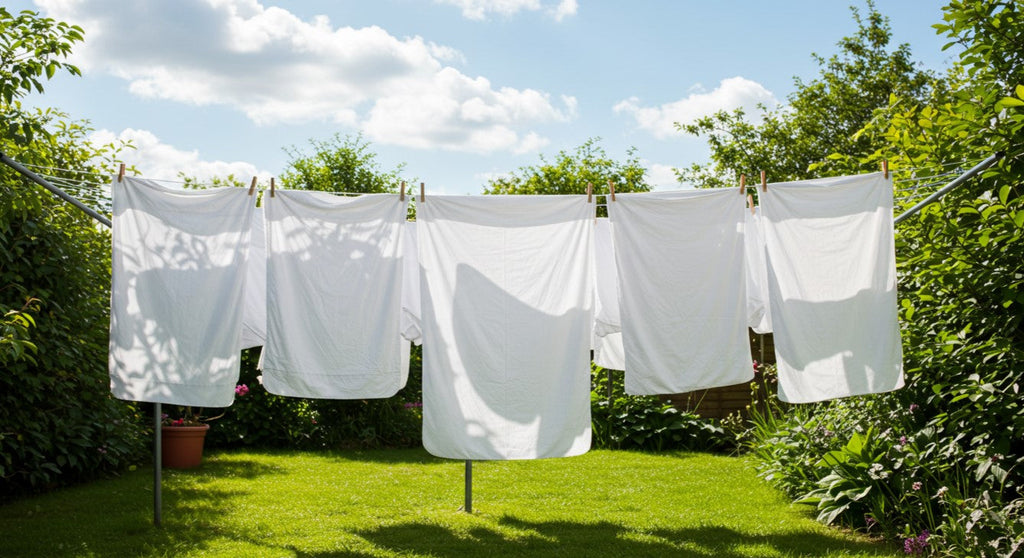The Ultimate Guide to Eco-Friendly Laundry: 8 Hacks to Save Water, Energy & Money
Posted by Y SONS

The laundry basket is overflowing again. It’s a familiar sight in almost every home, a quiet mountain of clothes that represents our daily lives. Without a second thought, we load up the washing machine, add detergent, and press start. The hum of the machine is a comforting sound of productivity.
But have you ever stopped to think about what’s really happening inside that machine? With every cycle, we use dozens of liters of precious water. We consume a surprising amount of electricity, mostly to heat that water. And the detergents we pour in eventually make their way back into our environment.
Laundry, as it turns out, has a significant environmental footprint.
The good news is that changing this doesn't require a complete life overhaul or expensive new equipment. The most powerful changes are a series of small, simple hacks, shifts in our habits that, when combined, create a massive impact. This guide is your complete roadmap to transforming your laundry routine from a resource-draining chore into a mindful, eco-friendly practice that is kinder to the planet and your wallet.

First, Let's Understand Laundry's Real Environmental Footprint
To appreciate the solution, we have to understand the problem. Why is a simple load of laundry such a big deal? It comes down to three key areas:
- The Water Hog: Traditional top-loading washing machines can use up to 150 liters of water for a single load. That’s more water than many people in drought-stricken areas use in several days. While high-efficiency (HE) machines are much better, the sheer frequency of washing still adds up to a staggering amount of water consumption.
- The Energy Vampire: Here’s a fact that surprises most people: about 90% of the energy a washing machine consumes is used just to heat the water. The actual tumbling and spinning use very little electricity in comparison. When you choose a hot wash, you are essentially paying to heat a huge tub of water for an hour, only to send it right down the drain.
- The Chemical Question: Many conventional laundry detergents contain phosphates, surfactants, and other chemicals that can be slow to biodegrade. When they enter our waterways, they can disrupt aquatic ecosystems. Furthermore, the bulky plastic jugs they come in contribute to plastic pollution.
Seeing it laid out like this can feel daunting, but it also reveals exactly where we can make the most effective changes.
The Game-Changers: 3 Foundational Eco-Friendly Habits
If you only change three things about your laundry routine, make it these. They are the easiest to adopt and have the biggest positive impact.
Hack #1: Wash Full Loads Only
This is the golden rule of eco-friendly laundry. Your washing machine is designed to work most efficiently when it's full (but not overstuffed!). It will use roughly the same amount of water and energy to wash a half-empty load as it does a full one.
How to do it right: Wait until you have a genuine full load before running the machine. If you absolutely need a specific item washed, consider hand-washing it in the sink instead of running a whole cycle. A full load means the drum is about three-quarters full, leaving enough space for clothes to tumble freely.
Hack #2: Embrace the Cold-Water Wash

This is the single most effective energy-saving hack on this list. Given that 90% of the energy is used for heating, switching from a hot (60°C) or warm (40°C) wash to a cold (30°C or below) wash slashes your energy consumption for that load by up to 90%.
But will my clothes actually get clean? Yes! This is the biggest myth of modern laundry. Years ago, detergents needed hot water to activate their enzymes. Today, detergent technology has advanced significantly. Modern formulas are designed to work brilliantly in cold water, effectively lifting stains and neutralizing odors. Unless you are washing heavily soiled items like cloth diapers or greasy work clothes, cold water is more than capable.
Hack #3: Rethink "Dirty" Wear More, Wash Less
We live in a culture of over-washing. A shirt worn for a few hours in an air-conditioned office or a pair of jeans worn to the grocery store are not truly "dirty." The fashion industry and detergent companies have conditioned us to think that every item needs to be washed after a single use.
How to do it right: Adopt a new system. If an item is visibly stained or smells, it goes in the hamper. If it doesn't, air it out overnight by hanging it on a hook or the back of a chair. You’ll be shocked at how fresh it is in the morning. Jeans, sweaters, and jackets can often go for multiple wears before needing a wash. This simple habit not only saves massive amounts of water and energy over time but also dramatically extends the life of your clothes.
Next-Level Hacks: Optimizing Your Wash for Peak Efficiency
Once you've mastered the basics, you can fine-tune your process to save even more.
Hack #4: Choose Your Detergent Wisely
The type of detergent you use plays a huge role in your eco-laundry journey. Here's what to look for:
- Concentrated Formulas: Liquid detergents are often more effective in cold water than powders, which can sometimes struggle to dissolve fully. Look for concentrated formulas. They require you to use less product per wash and come in smaller packaging, which reduces plastic waste and the carbon footprint of shipping.
- Biodegradable Ingredients: Choose detergents with plant-based, biodegradable ingredients that are gentler on the environment when they are washed down the drain.
- Cold-Water Power: Ensure your chosen detergent is explicitly designed for high performance in cold water.

A great example of a product that aligns with these principles is a detergent like YSons Aqua Shine Liquid Detergent. Its concentrated liquid formula is designed to be effective in all temperatures, including the energy-saving cold wash, helping you get a brilliant clean without the environmental cost of heating water. When you pair a powerful cold-water detergent with a cold-water cycle, you get the best of both worlds: clean clothes and a clean conscience.
Hack #5: The Simple Power of a Pre-Soak
Have a stubborn stain on a shirt? The instinct is to throw it in a hot, heavy-duty wash cycle. A much more energy-efficient method is to pre-soak. Soaking the stained item in a small basin of cold water with a dab of liquid detergent for an hour can loosen the stain dramatically. After soaking, you can wash it in your normal cold-water load, and it will come out perfectly clean without any extra energy or a second wash cycle.
The Drying Revolution: Ditching the Energy-Hungry Dryer
We’ve focused a lot on the washing machine, but the tumble dryer is arguably the most energy-hungry appliance in the entire home. Ditching it, or at least using it smarter, is a cornerstone of eco-friendly laundry.
Hack #6: Fall in Love with Line Drying

There is nothing quite like the smell of sun-dried sheets. Line drying your clothes is completely free, consumes zero energy, and is far gentler on your fabrics than the high heat of a dryer. The sun's UV rays even act as a natural disinfectant and stain-remover.
Tips for perfect line drying:
- Hang clothes on a line outdoors or on a collapsible rack indoors near a window.
- To prevent clothes (especially towels and jeans) from becoming stiff, give them a good, hard shake before hanging them up.
- Hang whites in the sun to brighten them and colors in the shade to prevent fading.
Hack #7: If You Must Machine Dry, Do It Smarter
For many, line drying isn't always practical. If you need to use a machine dryer, follow these rules:
- Clean the Lint Filter After Every Single Load: A clogged filter restricts airflow, forcing the dryer to work harder and longer.
- Use Wool Dryer Balls: These reusable woolen balls bounce around in the dryer, separating clothes so they dry faster. They also reduce static, eliminating the need for single-use dryer sheets.
- Don't Over-Dry: Most dryers have a moisture sensor setting. Use it! It will automatically shut the machine off when the clothes are dry, preventing wasted energy and fabric damage.
The Big Picture: Beyond Just Wash Day
Hack #8: Care For Your Washing Machine
An efficient machine is an eco-friendly machine. Once a month, run an empty "maintenance wash" on the hottest cycle with a cup of white vinegar instead of detergent. This will clean away soap scum and mineral buildup, helping your machine run more efficiently and last longer.

Your Laundry Room, Your Impact
Becoming an eco-friendly laundry pro isn't about achieving perfection overnight. It's about making one small change at a time. Start by committing to only washing full loads. Next week, try switching to a cold wash. Maybe next month, you invest in a drying rack.
Each of these hacks is a step in the right direction. Together, they form a powerful new routine that conserves our planet's precious resources, saves you real money on your utility bills, and even helps your beloved clothes last longer. Your laundry room may just be the most impactful place in your home to start making a difference.



